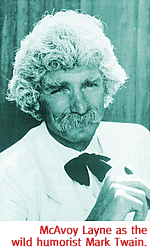Wind Storm
The Tucson Symphony Orchestra Breaks New Ground With An Exciting Old Work.
By Margaret Regan
R. CARLOS NAKAI naturally is getting most of the advance
attention for this weekend's Tucson Symphony Orchestra concert.
Perhaps the premiere player of the Native American flute, Nakai
will perform with the orchestra on two works by James DeMars,
"Spirit Horses" and "Two World Symphony."
Both pieces combine the distinctive sounds of the New World flute
with the more familiar tones of Old World instruments. And Nakai
is expected to bring in a crossover audience nowadays so prized
by arts promoters: In this case, fans of traditional and New Age
music will mix with the classical crowd.
But the concerts, set for Thursday and Friday evenings and Sunday
afternoon, will also offer up a razzle-dazzle Schumann concerto
for horns and orchestra, a work so challenging it's rarely heard
live.
"The four solo horns are standing up in front," gleefully
reports first horn Jacquelyn Sellers. "We don't sit in the
back like we normally do. It's pretty spectacular writing for
the horn. It's probably the most difficult piece I've ever played."
 Though she and the three other horn players have been planning
their performance of the Schumann Konzertstück, op.
86, for about two years, Sellers is good-natured about the flurry
of publicity for Nakai. "We've been kidding that we're the
warm-up band for Nakai," she says.
Though she and the three other horn players have been planning
their performance of the Schumann Konzertstück, op.
86, for about two years, Sellers is good-natured about the flurry
of publicity for Nakai. "We've been kidding that we're the
warm-up band for Nakai," she says.
Part of what makes the Konzertstück so unusual, Sellers
explains, is the simple fact that it's an orchestral piece that
gives the horns a starring role. There are only about three such
works in existence. Composed in 1849, Sellers says the piece owes
its life to a technological breakthrough: the invention of the
valve. The valve transformed the horn from a lowly rhythmic instrument
into a musical instrument capable of sounding every note in the
chromatic scale. Schumann rushed to compose one of the first pieces
for the new valved horn, and he was so excited by the new instrument's
possibilities that he created music that is wildly exultant--and
technically very difficult to play.
"It takes four really fantastic horn players," Sellers
says. "I wouldn't have done this 10 years ago. (Former musical
director) Bob Bernhardt asked me some years ago if I thought the
horn section was ready to do the Konzertstück. I had
to say no. So he said, 'Let me know when you're ready.' Two years
ago, I told him we were, and one month later he was out of here.''
 Nevertheless, the piece was put on the schedule and rehearsals
began. First horn Sellers, who's now been with the orchestra for
15 years, is joined in the work by Kristine Crandall, Victor Valenzuela
and Shawn Campbell. Sometimes it was tough going.
Nevertheless, the piece was put on the schedule and rehearsals
began. First horn Sellers, who's now been with the orchestra for
15 years, is joined in the work by Kristine Crandall, Victor Valenzuela
and Shawn Campbell. Sometimes it was tough going.
"After a particularly hard rehearsal, I said, 'We're only
gonna do this once.' "
But the horn players have since been invited to reprise the piece
at the International Women's Brass Conference in St. Louis in
June, this time with a piano instead of a full orchestra, and
Sellers says they'll probably do it again someday with TSO.
"It's a special occasion though," she says. "It's
not going to happen again anytime soon."
Tucson Symphony Orchestra presents the concert Old World
Meets New at 8 p.m. Thursday and Friday, February 20 and
21, and at 2 p.m., Sunday, February 23, at the TCC Music Hall,
260 S. Church Ave. Along with the Schumann work and DeMars' two
pieces, the TSO will play "The Miraculous Mandarin Suite"
by Béla Bartók. Tickets range from $7 to $26. If
any tickets remain 15 minutes before show time, students with
valid ID may buy rush tickets for $3. For reservations and information,
call 882-8585.

|
